
How to Use 12800mah battery 18650 Li-ion 12.8 Ah : Examples, Pinouts, and Specs
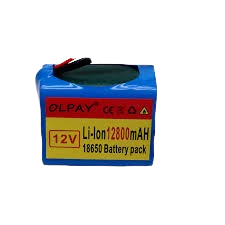
 Design with 12800mah battery 18650 Li-ion 12.8 Ah in Cirkit Designer
Design with 12800mah battery 18650 Li-ion 12.8 Ah in Cirkit DesignerIntroduction
The 12800mAh Battery 18650 Li-ion 12.8 Ah by OPLAY (Manufacturer Part ID: Lithium Battery Packs) is a high-capacity rechargeable lithium-ion battery. With a capacity of 12.8Ah, this battery is ideal for applications requiring long-lasting power and high energy density. It is widely used in portable electronics, electric vehicles, power banks, and backup power systems. Known for its durability and long cycle life, this battery is a reliable choice for energy storage and delivery.
Explore Projects Built with 12800mah battery 18650 Li-ion 12.8 Ah
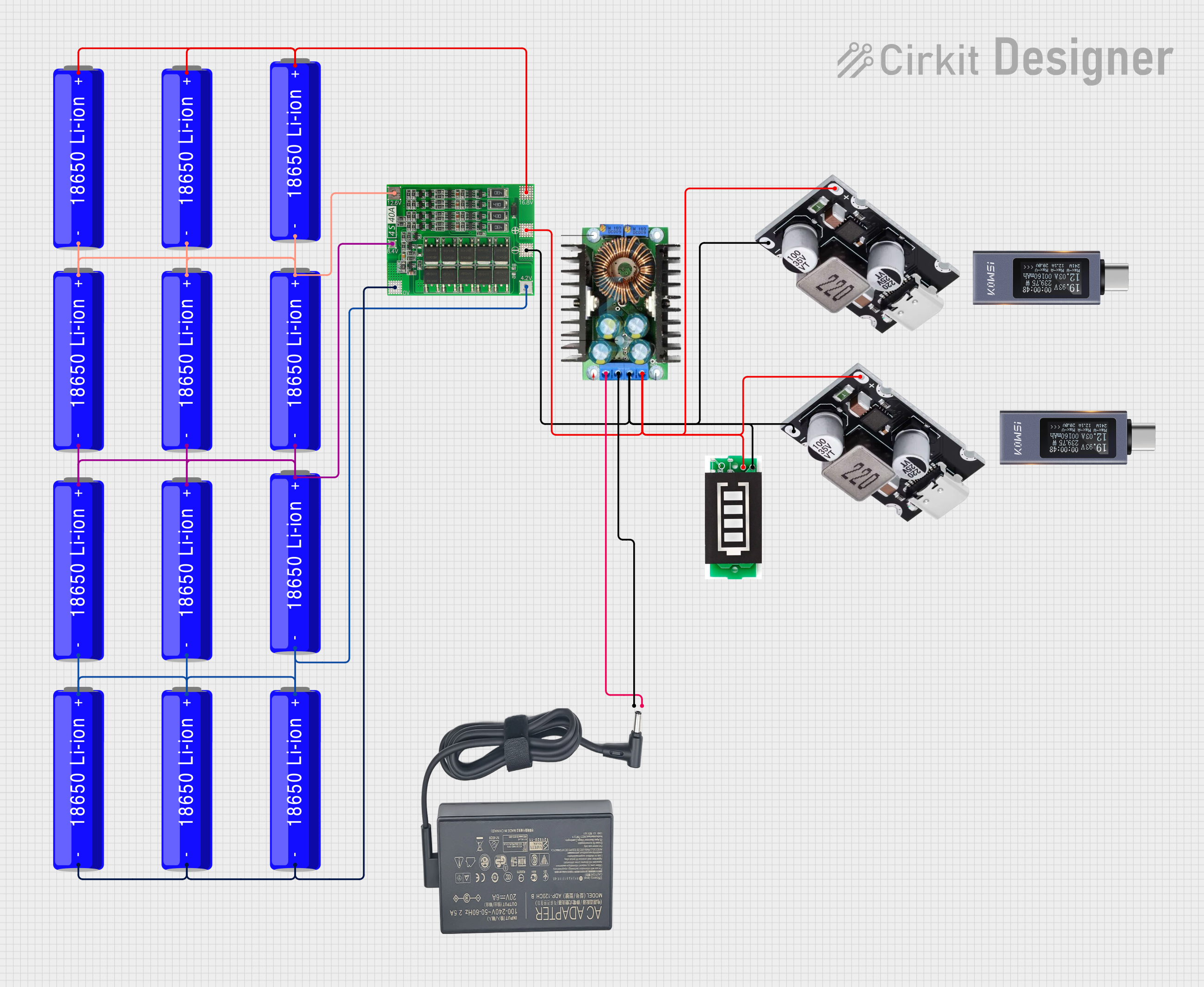
 Open Project in Cirkit Designer
Open Project in Cirkit Designer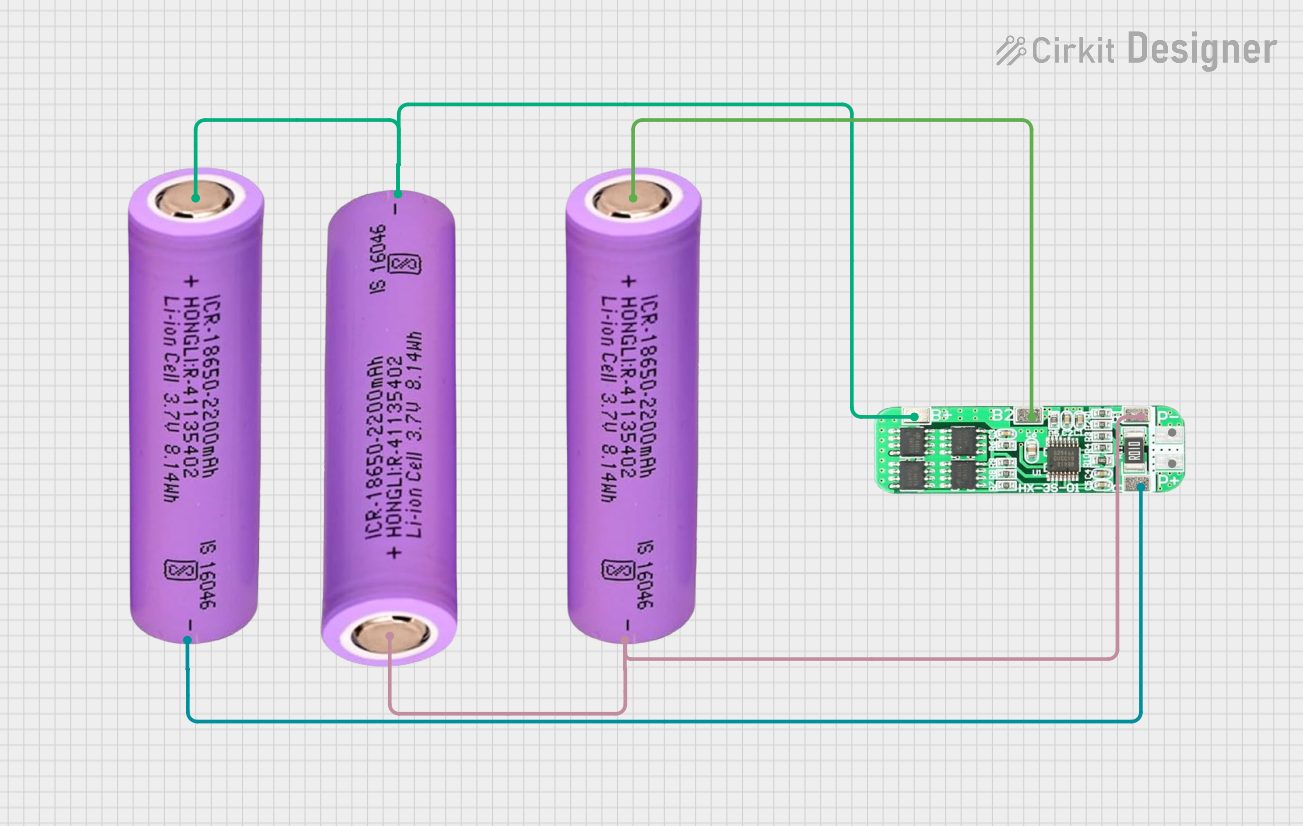
 Open Project in Cirkit Designer
Open Project in Cirkit Designer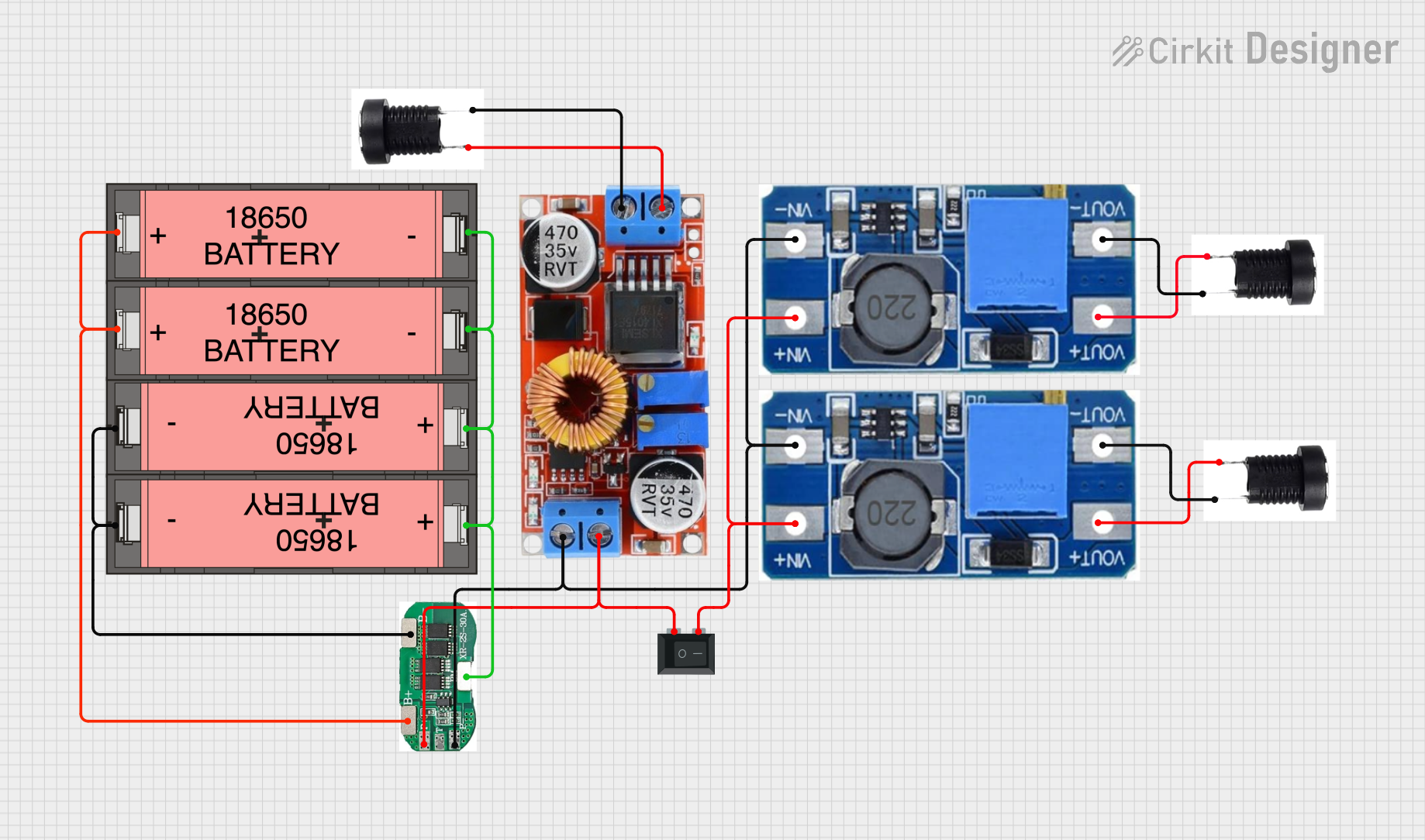
 Open Project in Cirkit Designer
Open Project in Cirkit Designer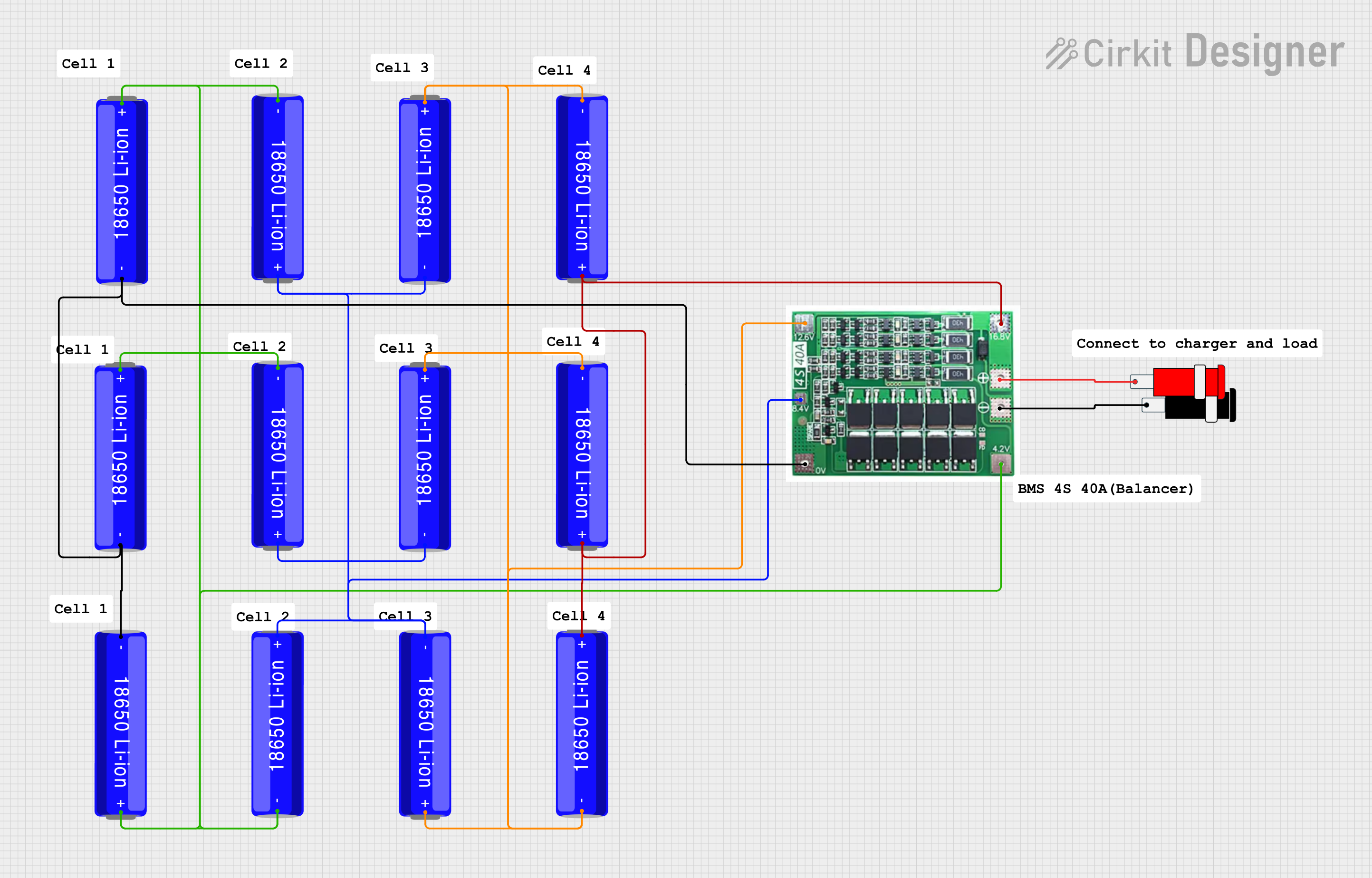
 Open Project in Cirkit Designer
Open Project in Cirkit DesignerExplore Projects Built with 12800mah battery 18650 Li-ion 12.8 Ah

 Open Project in Cirkit Designer
Open Project in Cirkit Designer
 Open Project in Cirkit Designer
Open Project in Cirkit Designer
 Open Project in Cirkit Designer
Open Project in Cirkit Designer
 Open Project in Cirkit Designer
Open Project in Cirkit DesignerCommon Applications
- Portable electronic devices (e.g., laptops, cameras, and handheld tools)
- Electric vehicles and e-bikes
- Power banks and uninterruptible power supplies (UPS)
- Solar energy storage systems
- Robotics and IoT devices
Technical Specifications
Below are the key technical details of the 12800mAh Battery 18650 Li-ion 12.8 Ah:
| Parameter | Specification |
|---|---|
| Nominal Voltage | 3.7V per cell (typically 7.4V or 11.1V in packs) |
| Capacity | 12,800mAh (12.8Ah) |
| Chemistry | Lithium-ion (Li-ion) |
| Maximum Discharge Rate | 2C (25.6A) |
| Charging Voltage | 4.2V per cell |
| Charging Current | Standard: 0.2C (2.56A), Max: 1C (12.8A) |
| Cycle Life | ≥500 cycles (at 80% capacity retention) |
| Operating Temperature | Charge: 0°C to 45°C, Discharge: -20°C to 60°C |
| Dimensions | Varies by pack configuration |
| Weight | Approx. 45g per cell |
Pin Configuration and Descriptions
For battery packs with integrated protection circuits, the pin configuration is as follows:
| Pin | Label | Description |
|---|---|---|
| 1 | + (Positive) | Positive terminal for power output |
| 2 | - (Negative) | Negative terminal for power output |
| 3 | BMS (Optional) | Battery Management System communication pin (if present) |
Note: Always verify the pin configuration for your specific battery pack model.
Usage Instructions
How to Use the Battery in a Circuit
- Connection: Connect the positive terminal (
+) to the positive rail of your circuit and the negative terminal (-) to the ground rail. Ensure proper polarity to avoid damage. - Charging: Use a compatible lithium-ion battery charger with a constant current/constant voltage (CC/CV) charging profile. Set the charging voltage to 4.2V per cell and limit the current to the recommended value (e.g., 0.2C for standard charging).
- Discharging: Ensure the load does not exceed the maximum discharge rate (2C or 25.6A for this battery). Use a protection circuit to prevent over-discharge.
- Protection: If the battery pack includes a Battery Management System (BMS), it will handle overcharge, over-discharge, and short-circuit protection. If not, consider adding an external BMS.
Important Considerations and Best Practices
- Avoid Overcharging: Never exceed 4.2V per cell during charging, as this can damage the battery and pose safety risks.
- Prevent Over-Discharge: Do not allow the voltage to drop below 2.5V per cell, as this can reduce the battery's lifespan.
- Temperature Monitoring: Avoid charging or discharging the battery outside the recommended temperature range.
- Storage: Store the battery in a cool, dry place at around 40-60% charge for long-term storage.
- Safety: Do not puncture, crush, or expose the battery to fire or water.
Example: Using the Battery with an Arduino UNO
To power an Arduino UNO with this battery, follow these steps:
- Use a step-down voltage regulator (e.g., LM7805) to convert the battery's voltage to 5V.
- Connect the regulator's output to the Arduino's
VINpin and ground.
Sample Code for Monitoring Battery Voltage
You can monitor the battery voltage using an analog pin on the Arduino UNO:
// Define the analog pin connected to the voltage divider
const int batteryPin = A0;
// Voltage divider resistor values (in ohms)
const float R1 = 10000.0; // Resistor connected to battery positive
const float R2 = 10000.0; // Resistor connected to ground
void setup() {
Serial.begin(9600); // Initialize serial communication
}
void loop() {
// Read the analog value (0-1023)
int analogValue = analogRead(batteryPin);
// Convert the analog value to voltage
float batteryVoltage = (analogValue * 5.0 / 1023.0) * ((R1 + R2) / R2);
// Print the battery voltage to the Serial Monitor
Serial.print("Battery Voltage: ");
Serial.print(batteryVoltage);
Serial.println(" V");
delay(1000); // Wait for 1 second before the next reading
}
Note: Use a voltage divider to ensure the battery voltage does not exceed the Arduino's input voltage range (0-5V).
Troubleshooting and FAQs
Common Issues and Solutions
Battery Not Charging
- Cause: Faulty charger or incorrect charging voltage.
- Solution: Verify the charger is compatible with lithium-ion batteries and set to 4.2V per cell.
Battery Drains Quickly
- Cause: High discharge rate or aging battery.
- Solution: Reduce the load or replace the battery if it has reached the end of its cycle life.
Overheating During Use
- Cause: Excessive current draw or poor ventilation.
- Solution: Ensure the load is within the maximum discharge rate and improve airflow around the battery.
No Output Voltage
- Cause: Protection circuit triggered due to over-discharge or short circuit.
- Solution: Recharge the battery to reset the protection circuit.
FAQs
Q: Can I use this battery in series or parallel configurations?
A: Yes, but ensure all cells are balanced and use a BMS to manage the pack.Q: How do I know when the battery is fully charged?
A: The charger will indicate full charge when the current drops to a minimal value at 4.2V per cell.Q: Is this battery safe for air travel?
A: Check airline regulations, as lithium-ion batteries are subject to specific restrictions.Q: Can I use this battery without a BMS?
A: It is not recommended. A BMS ensures safe operation by preventing overcharge, over-discharge, and short circuits.
By following this documentation, you can safely and effectively use the 12800mAh Battery 18650 Li-ion 12.8 Ah in your projects.